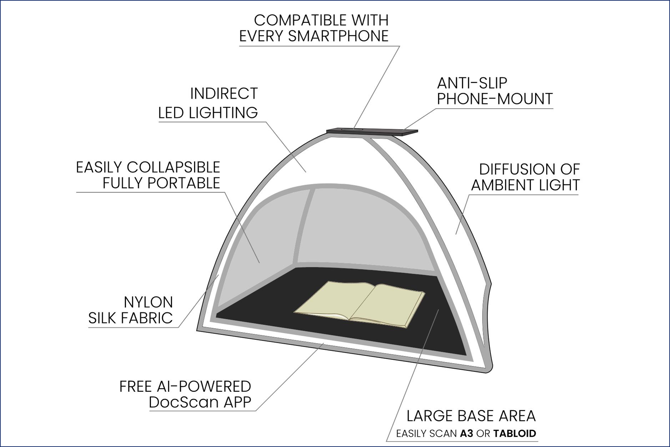ScanTent
The ScanTent is the optimal solution for scanning loose or bound documents on the go – for low-cost and high-quality scans.
The ScanTent is a convenient tool that empowers you to convert historical documents and books into digital format using just your smartphone. This portable equipment securely holds your smartphone above the document, ensuring steady and clear images.
Using the ScanTent together with DocScan, a mobile app, ensures the quick and efficient capture of high-quality images, without the need for a specialized book scanner. This way, users can effortlessly upload images from DocScan directly to the Transkribus platform, where they can harness the power of Handwritten Text Recognition technology.
When working with DocScan and the ScanTent, users can expect to efficiently scan a 300-page book (equivalent to 150 images) within approximately 12-15 minutes. As a general guideline, it is possible to capture over 500 images in just one hour.
Main features
- Professional photo environment for taking high quality pictures without any extra light (white nylon silk fabric)
- LED lightning with USB power supply for indirect illumination of the documents (if necessary)
- Black neoprene fabric at the base for a standardized background
- Large base area so that users can place their arms inside the ScanTent to hold bound documents open with both hands
- Scanning of documents of around A3 size or even a bit larger
- Lightweight (~ 500 gram) and collapsible
Assembling the ScanTent
The ScanTent includes the following components:
- 1 x White tent fabric
- 4 x Tent poles
- 1 x Smartphone mount
- 1 x Neoprene base (~ 55cm x 70cm x 60cm)
- 1 x LED strip for low-light conditions (with USB type-A plug)
- Bag for storage/transport

Assembling the ScanTent is a simple and straightforward process that anyone can easily follow.
To help you with the setup, we have created a video tutorial that walks you through each step to get the ScanTent ready to use.
- To begin setting up the ScanTent, lay out the white tent fabric upside down on the black neoprene base.
- Then, insert the smartphone mount also upside down, with the circular part facing upwards.
- Next, thread the tent poles through the fabric. Insert one end of each pole into one of the four holes around the edge of the circular mount.
Once secured in the mount, thread the other end of each pole into the fabric sleeves at the corners of the tent. Repeat this process for all the remaining poles.
This step may require some slight effort for the last two poles, as it will create tension and give the tent its shape. - To wrap it up, close the tensioning strap and turn the assembled tent around, placing it on top of the neoprene base. This black fabric provides a standardised background for your documents and helps to enhance the quality of the images. It also allows you to place your arms inside the ScanTent, giving you the ability to hold bound documents open with both hands.
- If your ScanTent or Mount is not quite straight or level, make sure the poles are properly in place. Try adjusting the tensioning strap at bottom, and wiggle the tent into place.
- Congratulations! You are now all set and ready to begin scanning!
If you are working in low-light conditions, you can use the LED strip provided with the ScanTent. Simply connect the USB type-A plug to a power source such as a power bank or a laptop, and the LED strip will provide indirect illumination for your documents.
Finally, when you are finished using the ScanTent, you can easily disassemble it and store it in the included bag. The ScanTent is lightweight and collapsible, making it convenient to carry and transport in small suitcases.
Possible use cases
-
Archives and Libraries
The ScanTent and DocScan app are excellent alternatives to the usual book scanning devices within archives and libraries.
The main advantages are:
-
- High quality images – modern smartphones deliver excellent image quality with high resolution
- Cost efficient – both for end-users as well as for the library/archive
- No user support needed from the archive or library – users will get familiar with the DocScan app on their own
- Copyright friendly – users take and store images on their personal device (although the option to provide a phone owned by the library or archive is also possible, of course)
-
Scanathons
ScanTents can be used by libraries and archives interested in organizing Scanathons.
The event could work as follows:
-
- A library or archive contacts potential volunteers among their users and buys (or rents) e.g. 20 ScanTents
-
- A specific (historical) collection is selected for scanning, e.g. documents relating to a “local hero”
- Volunteers bring their own smartphones and receive guidance from the library or archive staff on how to use the DocScan app and the ScanTent equipment
- A scanning session takes place for e.g. 2 hours
- The Scanathon could be repeated the next day or even become a weekly activity for volunteers
Within 2 hours, each volunteer will be able to scan up to 1000 images (or 2000 book pages) from. This means that 20 volunteers will produce up to 20.000 images or 40.000 book pages within one session!
The speed may be slower with more delicate archival material but volunteers will still be able to generate tens-of-thousands of high quality images.
The ScanTent can be order via PayPal or Credit Card payment option from here: ScanTent
Next step: DocScan app
